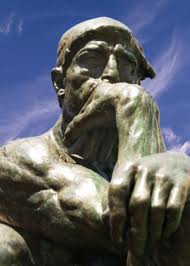An unexamined life is not worth living (Socrates)
For a human being, thinking is inevitable. Tod@s we think. Even if you don’t want to do it. But our thinking tends to be influenced by factors that we are not aware (biases, prejudices, …), which affect the quality of our reasoning. Be aware of these factors is of vital importance both in the search as in the evaluation of the information.
Is there any way to bring those factors to the consciousness?: yes, critical thinking.
The application of critical thinking is not a necessity less. In a recent study, reviewed in the Blok Bid, about the use and evaluation of information on the part of the american college students, we can grasp its importance. According to the study, 77% of the respondents evaluated the information based on the authorship and update, without taking into account other parameters. But the most striking is that 84% have problems to define the subject of your work or your need for information. And even 41% have difficulties to evaluate the reliability of the information.
As it seems, the difficulty in defining their need for information is because:
they are concerned that their choice meets the expectations of the teachers, as well as can handle the subject of your work as I have started and not be overwhelmed by the amount of information available.
One of the conclusions of the study is the need to foster in the students a group of skills “first-order”, involving critical thinking. But, what exactly is critical thinking?
The task of defining what is critical thinking, and to encourage their application, was carried out until recently by The Foundation for Critical Thinking. According to the Foundation, the critical thinking could be defined as:
that mode of thinking — about any subject, content,or problem — in which the thinker improves the quality of his or her thinking by skillfully analyzing, assessing, and reconstructing it.
Thus, critical thinking is a method for, as I said in the introduction, to bring to consciousness the factors that affect the quality of our thinking. It is, by its nature, a method that requires direction, involvement and discipline of the individual.
And what are those factors? According to the Foundation, every thought includes 8 elements:
- Purpose / Aim
- Question you are responding to
- Information on which it is based
- Inferences / Conclusions to which it gives rise
- Concepts / Ideas that define it
- Assumptions on which it rests
- Implications / Consequences that holds
- Points of view / Perspective in l@s that takes place
These eight elements can be examined systematically using the formulation of questions addressed. But critical thinking does not end here.
The Foundation also speaks to us about standards of thinking, which can be judged the quality any thought. We can identify, at least, 9 standards:
- Clarity
- Accuracy
- Precision
- Relevance
- Depth
- Amplitude
- Logic
- Significance
- Equity
Again, the standards affecting any thought can be examined through the systematic use of questions directed.
Critical thinking as a method can be applied both at an individual level and in interaction with others, and, needless to say, in the determination of our needs for information and in the evaluation of the results of a search.
I leave you with some questions: can you put into practice some technique of critical thinking in your everyday life?; and what in the search for information?; do you know any program of dissemination of critical thinking?
Resources:
In the above-mentioned Foundation for the Critical Thinking you will find a good amount of valuable resources, from definitions to the highly recommended online model on the elements and standards of thought.
Credits: Image taken from Art Informed
